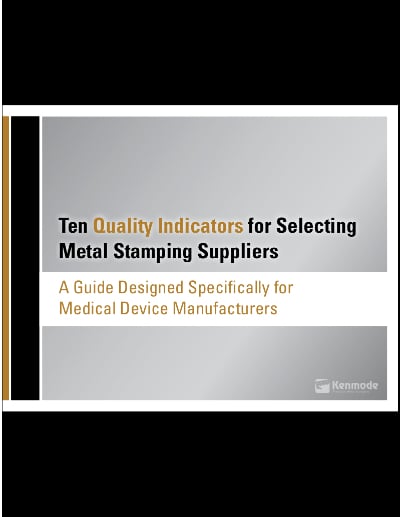Defective medical devices are costing manufacturers billions of dollars every year. Even more alarming, defects can lead to patient death and harm. According to the U.S. Food and Drug Administration, “Each year, the FDA receives several hundred thousand medical device reports of suspected device-associated deaths, serious injuries and malfunctions.”
For medical devices that rely on metal stampings, best quality practices include a focus on preventing, detecting and managing metal stamping defects. A reliable metal stamping firm will have the right processes in place to incorporate quality controls into every phase of a project – from design through shipment – as well as the right technology to monitor quality in real time.
To avoid defects, metal stampers will:
- Ensure that correct tooling parameters are established from the outset
- Define control plans
- Conduct initial capabilities studies to determine that the process is stable
- Confirm consistency in production runs on a continual basis
Preventing metal stamping defects
Prevention of problems is the metal stamper’s primary focus, involving both process tools and other methods to prevent metal stamping defects. For manufacturers, it pays to involve metal stampers earlier in the design process to ensure that the component part is designed for efficiency, durability, reliability, and manufacturability.
Sophisticated metal stamping suppliers understand the importance of risk management from the very beginning of the design and planning process and follow best practices in mitigating risks from design to launch to production and monitoring. Metal stamping engineers should be able to collaborate with their OEM clients in understanding the product risk and translating that understanding into reducing manufacturing risk by identifying, assessing and prioritizing associated risks and working to mitigate them.
One of the best tools used in risk management and risk mitigation is Failure Modes and Effects Analysis (FMEA), a process pioneered in the automotive industry, which applies to medical device stampings as well.
DQ/IQ/OQ/PQ is another important tool in preventing defects used by the Medical Device Industry, which relates to verification and validation of both design activities and manufacturing process development to ensure that the device will function as specified. Metal stampers are primarily involved with Operational Qualification and Performance Qualification, although they should demonstrate an understanding of the entire process.
Whenever possible, the metal stamper should mistake-proof its processes to eliminate the potential for problems. For example, tool design should consider classified features that require tighter tolerance and better dimensional stability. Designing better tooling “mistake-proofs” the process before tooling is even manufactured, and goes as far as to eliminate the possibility of tooling components being installed incorrectly in the tool during the maintenance cycle.
For further information on the advanced technology employed in ensuring metal stamping quality, refer to our blog article, “Prevention and Detection Systems Improve Quality Control.”
Detecting metal stamping defects
Although prevention is the best place to focus efforts, detection must be ongoing using automated inspection technology and statistical process control to constantly monitor production standards and identify variances as soon as possible. Metal stampers must continually employ quality control equipment to detect potential problems as quickly as possible, rather than just conduct random testing.
Automated inspection equipment, such as in-die sensors and video inspection systems, is critical for monitoring part quality and detecting problems. These systems provide instant measurements and transmit records throughout the manufacturing process, which then are charted via the statistical process control system (SPC) to detect variances.
Metal stamping sensor technology monitors the entire process and the critical dimensions of each part as it goes through the progressive steps of metal forming. The sensors are used in combination with press controls, which can automatically stop the presses when something goes wrong and shut down the system before a die crashes. Advanced in-die sensors protect the investment of the tooling, while eliminating the potential for non-conforming product.
For more information on how sensor technology can stop defective parts from being produced, see our blog article, “Metal Stamping Sensors Boost Efficiency, Quality.”
Managing metal stamping defects
Effective quality management involves the ability to take corrective actions to address problems and preventive actions to prevent problems, otherwise known as Corrective and Preventive Actions (CAPA). A metal stamping firm should demonstrate its grasp of CAPA in practice, as well as a solid methodology for Root Cause Analysis (RCA) to determine the true source of the problem, whether inside or outside of the tool, so it can be eliminated.
Metal stampers should have processes in place that allow them to learn from mistakes and apply the lessons learned to like processes. One helpful tool is to maintain a searchable database of problems and solutions accessible to employees all along the production line.
Not only does a robust IT system help the metal stamper achieve quality performance, but it also enables a customer to conduct quality audits more easily and quickly. For example, the metal stamper should be able to instantly retrieve such data as manufacturing records, inspection history, and shipping date by part number when required, which can help manufacturers in Medical Device Reporting and Post-Market Surveillance issues.
Change control to address metal stamping defects
When defects do occur and quality is compromised, the metal stamper should be ready to work with the medical device manufacturer on a change control process.
According to the FDA’s “Device Advice” for medical device manufacturers, “Change control is a complex process. Failure to have an adequate change control system can cause equally ‘complex’ results. Inadequate change control exposes a company to product liability actions, results in product recalls, causes internal confusion, and is a serious violation of the Quality System (QS) regulation.”
A metal stamping firm should have a change control process in place to ensure that no change is made without advance notice and client approval. The metal stamping firm should provide change planning and validation/qualification to ensure quality and address risk management issues well in advance.
Potential changes that may affect metal stamping suppliers include:
- Product design
- Components
- Processes
- Materials
- Suppliers
- Manufacturing or test equipment
- Facilities
- Packaging
To learn more, please refer to our blog article, “Avoid Quality Issues by Implementing a Change Control Process.”
For an overview of best quality practices in metal stamping for medical devices, please download our free eBook: “Ten Quality Indicators for Selecting Metal Stamping Suppliers.”


